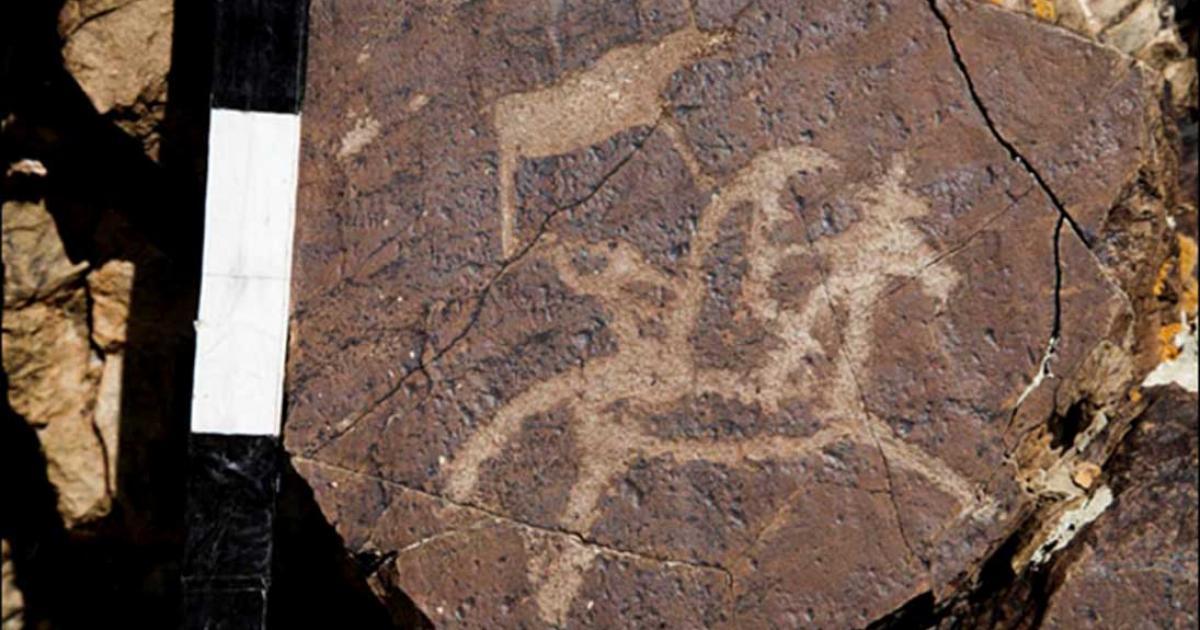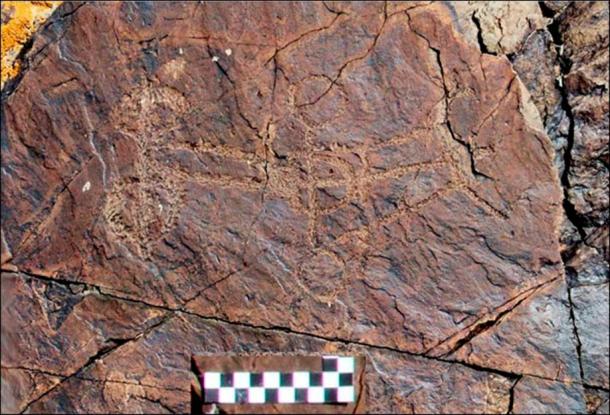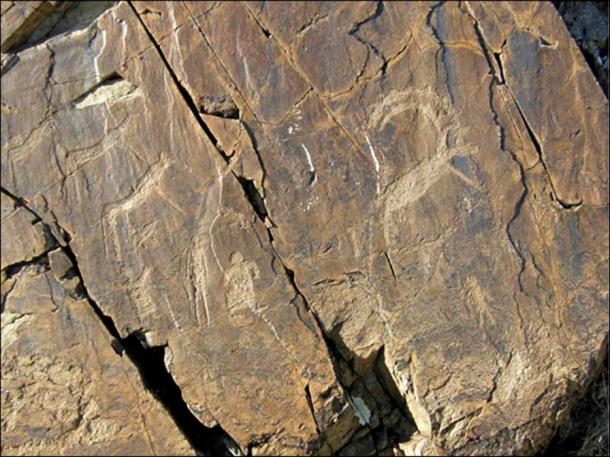
Mountainside Gallery Where All Civilizations Added Their Own Art from Bronze Age to Medieval Times
By The Siberian Reporters -Sergey Zubchuk and Olga Gertcyk
On the border between Russia and Mongolia, we reveal awe-inspiring Kara-Turug petroglyphs, and they contain a BIG secret about ancient Siberia.
There are 500 or so exhibits and the artwork here spans some 4,000 years until the end of the first millennium AD. Every major civilization added their own distinct imprint to the collection of rock art at Dus-Dag mountain, in modern-day Tuva Republic - literally from the age of the spear until well into medieval times.
Archaeologist, Dr Marina Kilunovskaya said: 'This way they were marking their presence, showing that they were now the owners here.'
To their credit, successive civilizations coming here did not destroy the jottings of those who went before them.

There are about 500 exhibits on Kara-Turug. Image: Marina Kilunovskaya
Each new incoming group on this crossroads of ancient civilizations enriched the collection with their own artistic flourishes.
In truth, they probably came here for salt - there are copious local supplies - but they left their etchings depicting their life and beliefs, and they remain with us today.
'The petroglyphs were made by people who lived in this area in different times, starting from the Bronze Age in the third millennium BC,' said the academic, who is senior researcher at the Department of Archaeology of Central Asia and Caucasus, Institute of the History of Material Culture, in St. Petersburg.
Her insights are riveting after painstaking research this summer into these hitherto unstudied petroglyphs.
- The Mysterious Petroglyphs of Ometepe, Nicaragua
- Huge Waves Provide Rare Glimpse of Hawaiian Petroglyphs

'The most popular image - a bull. This was an epoch of the bull.' Image: Marina Kilunovskaya
Not Totally Nomadic?
In a nutshell, she suggests that this rock art tells us that some of the oldest of the great nomadic cultures that, over several millennia populated Siberia, may not have been as nomadic as we thought.
In the Bronze Age, petroglyphs at Kara-Tarag she has detected evidence of houses, with homely domestic scenes.

Bronze Age rock art that seems to depict a domestic scene or floor plan.

Sketch of a ’floorplan’ petroglyph (Images: Marina Kilunovskaya)
'I am suggesting that ancient nomads knew how to build houses and they depict these houses,' she told The Siberian Times.
Archaeological discoveries tell us that ancient populations built log structures for burial chambers 'but it seems to me these (drawings) are real houses' in which Bronze Age families actually lived.
She explained: 'There are mainly domestic scenes but there also are images of houses in the Bronze Age. And what is surprising is that these are regular houses with roofs, although we are used to thinking that nomads lived in yurts.'
The images of houses, sometimes even included floor plans.
They indicated that, for example, these ancients, predating the Scythians, led not only nomadic life but were also familiar with long term domestic life.
They put down roots.
Did the Nomads Build Houses?
The rock images evidently do not show similar houses in Scythian times, yet archaeologists know they had the skills to build them from the impressive burial chambers which have been preserved right the way through to our times. For example in the Ukok plateau in the high Altai Mountains, and the Arzhan I and II sites in Tuva.

Petroglyph includes what could be another house scene (Image:Marina Kilunovskaya)
They built them for their dead, so it is not unreasonable to suppose they also used them for the living.
'The images of houses are unique,' explained Dr Kilunovskaya.
'According to our understanding, nomads had no houses - but they were burying their dead in log cabins. Funeral chambers were made of wood which means they had understanding about 'wood architecture'.

Wooden burial chambers in Arzhan-2, Pazyryk and Ak-Alakha burial mounds. Pictures: Konstantin Chugunov, Anatoli Nagler and Hermann Parzinger; mazimus101, Vladimir Mylnikov/Science First Hands
'We might be seeing houses of the dead (in this rock art) although, I think, we are seeing domestic scenes. There are couples depicted around houses and animals: goats, bulls, and dogs.'
She is currently engaged on a thesis to untangle these issues but talked us through the sweep of history depicted here in petroglyphs.
- 4,000-Year-Old Art Gallery Found in Siberia
- Why Would You Cremate and Bury Your Home? A Bizarre Viking Ritual Explained

Wooden burial chambers in Arzhan-2, Pazyryk and Ak-Alakha burial mounds. Pictures: Konstantin Chugunov, Anatoli Nagler and Hermann Parzinger; mazimus101, Vladimir Mylnikov/Science First Hands
Beginning With Bronze Age Migrants
'We discovered a unique monument of rock art at Kara-Turug, which has 20 groups of petroglyphs,' she said.
In other words, the ancient art gallery with 20 different viewing spots for these remarkable petroglyphs.
'The earliest we can date to the Bronze Age,' she said.
'The Bronze Age era is the time of the first wave of migration to Central Asia, Mongolia, and the Sayano-Altai highlands, when an Indo-European population came here.
'They were cattle breeders, moving along the 'steppes corridor' to the east. These people left numerous archaeological sites here ... They also left specific rock art.’
'It is special style in depicting animals. The most popular image - a bull. This was an epoch of the bull. And creatures that were somehow related to the bull - well-known horned faces, so-called masks, of gods with horns.’
'At that time, battle scenes also appeared and, at the end of Bronze Age, images of chariots.


Bronze Age chariot. Images: Marina Kilunovskaya
'As for the houses... I believe that they are related to the late Bronze Age, to the pre-Scythian time.... The houses are surrounded by the drawings related to the Bronze age - of bulls and chariots.'
Scythian Times
She said: 'The next layer are the Scythian petroglyphs. For them the central deity was the deer. So we see deer appearing on the rocks.

'For Scythians the central deity was the deer. So we see deer appearing on the rocks.' Image: Marina Kilunovskaya

Look closely and you will make out a deer.

Scythian time stag in Mongol-Transbaikal style. (Images: Marina Kilunovskaya)
'The drawings are not very naturalistic, so we presume this was kind of deity. Also, there are hunting scenes here.’
A Respectful Progression
'Then came the Xiongnu times. They have a special style, very dynamic. Scenes of hunting and battles.
'The next layer are drawn by the Turks. They loved to draw their warriors - in armor, with banners.'

Sketch of the Turk drawings of their warriors depicted in armor, with banners. Image: Marina Kilunovskaya
She said: 'Locals treated this ancient rock art with great reverence.' It was not vandalized.
There is one enduring likeness through these epochs, and it keeps repeating, she said.
'The one image depicted in all the epochs is a mountain goat or sheep. They all hunted this animal and it is on their drawings.’

'The one image depicted in all the epochs is a mountain goat or sheep.' Image: Marina Kilunovskaya
Technological Advances
'The methods of drawing differed in every epoch. The earliest stages - in the Bronze Age - they used sharpened bone and a stone. Bronze was not suitable. In Xiongnu times they begin to use iron, as they learned to make durable iron. And they begin to engrave the drawings. We can also say that Scythian masters always did sketches - with charcoal - and then engraved very thin lines before making general drawings over these lines.'
The end result is a treasure of epic proportions handed down from our ancestors, each epoch leaving their own imprint for future generations.
'No one has studied this territory before,' she said.
'I want to say big thanks to the Mongolian side [Institute of Archaeology of Mongolia] for the help in the research of these petroglyphs as they are located right on the border.
'This territory is quite hard to study, as this is a frontier area and special access from border guards is needed. But we managed to get the access and worked right on the border.'

Kara-Turug is located on the border between Russia and Mongolia, in the shore of Ubsunur lake. Picture: Marina Kilunovskaya
Top image: Every major civilization added their own distinct imprint to the collection of rock art at Dus-Dag mountain. (Image:Marina Kilunovskaya)
The article ‘Mountainside Gallery Where All Civilizations Added Their Own Art from Bronze Age to Medieval Times’ originally appeared on The Siberian Times and has been republished with permission.















